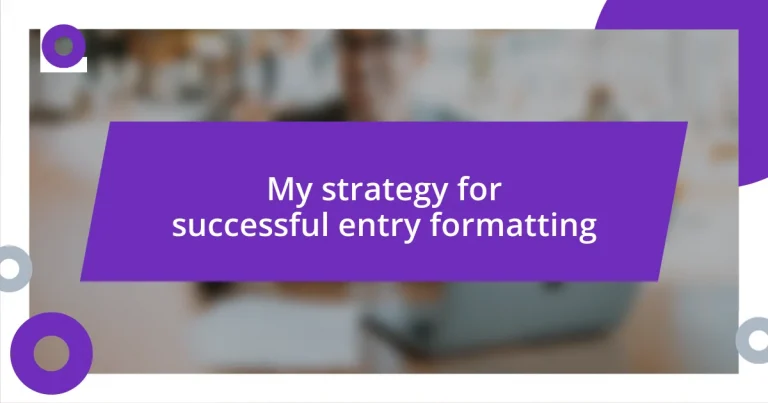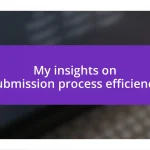Key takeaways:
- Effective entry formatting enhances clarity and reader engagement, allowing information to be easily understood and retained.
- Consistent formatting builds credibility and professionalism, which can significantly impact audience perception and trust.
- Utilizing appropriate tools and strategies, such as clear headings and visuals, is essential for effective communication and presentation of content.

Understanding entry formatting strategies
Understanding entry formatting strategies is essential for making a strong impression. I remember the first time I tackled a project where the format seemed more daunting than the content itself. Why does the presentation of information matter so much? Because it sets the tone for what follows and ensures your message isn’t lost in the chaos of poor organization.
I’ve realized that entry formatting isn’t just about aesthetics; it’s a strategic tool that guides the reader through your message. For instance, using bullet points can break down complex information, allowing readers to digest it easier. Have you ever skimmed through a dense paragraph and missed key details? I definitely have! That’s why I learned to prioritize clarity through thoughtful formatting.
It’s fascinating how small changes can lead to greater understanding. I once revamped a report simply by adjusting the headings and spacing, and the feedback was overwhelmingly positive. It made me wonder: how often do we overlook the power of well-structured entry formatting? There’s something rewarding about mastering it; it feels like unlocking a hidden potential in my communication skills.

Importance of consistent formatting
Consistent formatting acts like a roadmap for your readers, guiding them effortlessly through your content. I vividly recall preparing a presentation where inconsistent text sizes and erratic bullet points left my audience confused. They spent more time trying to decipher my slides than absorbing the information! This experience drove home the point that formatting isn’t merely a cosmetic concern; it’s pivotal in maintaining clarity and focus.
When information is presented uniformly, it enhances readability and comprehension. For example, I once edited a colleague’s document filled with varied fonts and no clear hierarchy. After aligning everything and establishing consistent styles, I could see the immediate difference in how much easier it was for others to follow along. This taught me that even the smallest formatting details can significantly impact how effectively your message is communicated.
Lastly, I’ve learned that consistent formatting builds credibility. Clients are naturally drawn to well-structured documents, and my first proposal that maintained formatting integrity won us a significant project. It was a lightbulb moment for me: all those subtle efforts in presentation reflected my professionalism and attention to detail. Have you ever noticed how polished formatting invites trust? I certainly have, and now I prioritize it in every piece of content I produce.
| Key Aspect | Impact of Consistent Formatting |
|---|---|
| Clarity | Helps readers easily grasp ideas and information. |
| Credibility | Builds trust and professionalism in your work. |
| Engagement | Maintains reader focus and reduces confusion. |

Choosing the right format style
Choosing the right format style is crucial for ensuring that your message resonates with your audience. I can recall an instance where I had to choose between a casual list format or a more formal paragraph structure for a project proposal. After some deliberation, I decided on the formal structure to reflect the seriousness of the content. The feedback was overwhelmingly positive; my audience appreciated the polished presentation, which reinforced my decision that format styles must align with the content and audience expectations.
Here are some key points to consider when selecting your format style:
- Audience: Understand who will read your content. A more casual audience may appreciate a lighter, bullet-point style, while a professional setting often requires a structured approach.
- Purpose: Define the goal of your content. Is it meant to inform, persuade, or entertain? The purpose can dictate your choice of format.
- Complexity: For dense information, I find using visuals or bullet points helps clarify and breaks down content into digestible pieces.
- Consistency: Whatever style you choose, stick to it throughout your document. I once changed a style mid-report, and I could see how it threw off my readers.
Choosing the right format style ultimately enhances your message.

Key elements of effective entries
A critical element of effective entries is the inclusion of clear headings and subheadings. They serve as signposts, allowing readers to navigate through sections effortlessly. I recall a time when I was sifting through a dense academic paper without headings; it felt like wandering a maze without an exit. This experience underscored for me just how pivotal well-structured headings can be in guiding readers to find the information they need quickly and efficiently.
Another key aspect is the careful use of visuals. Whether it’s charts, graphs, or images, they can break up dense text and provide a different perspective on your data. I once integrated a graph into a presentation to illustrate a complex trend, and the change in audience engagement was striking. It struck me then how much more effectively visuals can convey information than words alone sometimes do. Have you ever experienced that ‘aha’ moment when a graphic made something click into place?
Lastly, I believe that purpose-driven content is essential for effective entries. Every sentence should serve a distinct purpose, contributing to the overall message you want to convey. I once had a project where every paragraph seemed to drift without a clear focus, leading to confusion. After tightening the content to ensure each segment reinforced our core message, the clarity and impact improved tremendously. It’s a valuable lesson: do your entries breathe life into your main ideas, or do they merely fill space?

Tools for enhancing entry formatting
When it comes to tools for enhancing entry formatting, I’ve found that using word processing software effectively is essential. For instance, features like styles and formatting templates allow for uniformity across documents, making it easier to present information consistently. I remember the first time I discovered these features; I was amazed at how quickly I could apply headers and footers that aligned with my content. Have you ever spent hours on a report only to realize it looked disjointed? Streamlined formatting tools can save you from that frustration.
Another invaluable tool is collaborative platforms like Google Docs. They not only facilitate real-time editing but also allow team members to leave comments and suggestions on formatting. There was a project where my colleague pointed out some layout inconsistency during our brainstorming session. That small adjustment made a world of difference in how the final presentation was perceived. Have you experienced how a fresh pair of eyes can elevate your work?
Lastly, I can’t stress enough the importance of proofreading and editing tools, such as Grammarly or Hemingway Editor. These applications help refine not just language but also formatting by highlighting readability issues. I once overlooked a section that was convoluted and needed restructuring, which was brought to my attention by the Hemingway tool. It hit me then how essential it is to utilize technology to pinpoint areas that need improvement, ensuring clarity and engagement in our entries. After all, isn’t it satisfying when your work flows seamlessly?














